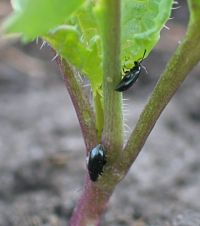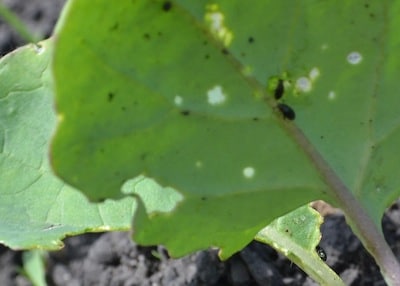

High winds may force flea beetles off leaf tops and down to leaf undersides and leaf stems. Stem feeding could make the flea beetle situation worse, since it takes just a few bites on a stem to nip off a whole cotyledon or sever the stem. Stem feeding, if it’s happening on a lot of plants, has a lower control threshold than the 25% damage recommended for leaf feeding.
Seed treatments should still be active for canola that was recently seeded and emerged quickly. Keep in mind that flea beetles have to feed to take up the insecticide, so some feeding damage is expected. Assess flea beetle numbers and species. Some research suggests the amount of feeding required for control may be greater for striped flea beetles. And at high numbers, flea beetles may overwhelm the seed treatment protection. Monitor the amount of leaf feeding to determine if this is occurring, and apply a foliar insecticide if the action threshold of 25% leaf area damage is exceeded and flea beetles are still actively feeding. Click here for images that show what different levels of leaf damage look like.
A number of foliar products are registered for flea beetles on canola. To find them, click your province for your guide to crop protection: Alberta Saskatchewan Manitoba.
While scouting, look to see if plants between rows have more damage. These could be untreated volunteers, and are not usually worth protecting.
